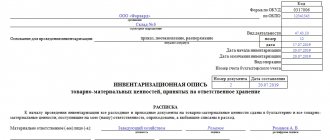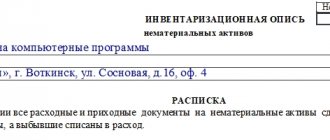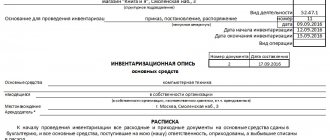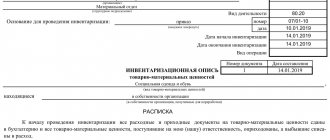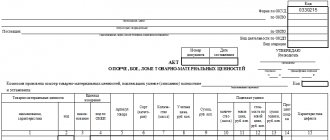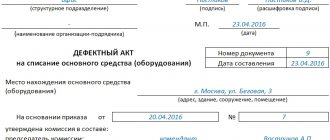Purpose of inventory of construction in progress
During the inventory, the commission must check the following:
- what is the condition of the construction projects, the construction of which has been temporarily interrupted or mothballed;
- Is there any special equipment included in the construction-in-progress that has been sent for repairs but has not yet been repaired?
For these objects, the commission must discover the reasons and grounds for conservation.
When listing the item “construction in progress”, those transactions that are recorded in the accounts are subject to verification:
- special equipment for installation (07);
- investments in non-current assets (08);
- settlements with contractors and suppliers (60).
Results
Reflection of unfinished capital investments in the balance sheet is carried out on line 1150, if the balance on the account is significant.
08 - on a separate line. Before drawing up annual reports, an enterprise is obliged to ensure the reliability of accounting data, for which an inventory is carried out, as well as an internal (and in cases established by law - external) audit of assets and liabilities. You can find more complete information on the topic in ConsultantPlus. Free trial access to the system for 2 days.
Purpose of inventory of work in progress
The objectives of carrying out an inventory of unfinished construction are as follows:
- detection of product defects that are not taken into account in accounting;
- determining the availability of products and semi-finished products whose processing is not completed;
- checking the accounting information for the movement of semi-finished products and parts, as well as the total amount of costs for work in progress;
- checking whether costs are correctly distributed by type of goods, as well as the cost of manufactured goods;
- determining the actual completeness of the reserves and the provision of the assembly with the required parts;
- determination of work in progress balances for orders that were canceled, as well as for those orders whose execution was interrupted.
Organization of inspection
The procedure for taking inventory of work in progress must be reflected in the company's accounting policies.
First of all, the director of the organization must issue an order indicating the following information:
- the reasons for the inspection;
- types of property that fall under the inventory;
- composition of the commission that carries out the inspection;
- start and end date of the inspection;
- deadlines within which all necessary documents must be submitted to the accounting department.
We can say that this order is an assignment for the inventory commission.
The commission for inventory of unfinished construction objects may include accounting employees, administration employees and other employees. During the inspection, workers carrying the mat must be present. responsibility.
Login to the site
Specialized publications for professionals Good afternoon, dear readers!
We bring to your attention the article “Inventory”, which, despite its name, discusses in detail various types of inventory, their frequency, procedure and other issues. Pay attention to the new offer from the magazine “Business Practice” - the “Getting Acquainted” program. In the “Practical Accounting” newsletter today there is an exclusive article by Nikolai Pekelnik “Metamorphoses with benefits”. I highly recommend reading it.
Kudinova A.S. Director of AF "Business Audit" Inventory
When conducting an inventory, you should be guided by: 1. Law of the Russian Federation of November 21, 1996 No. 129-FZ “On Accounting”. 2. Order of the Ministry of Finance of the Russian Federation dated July 26, 1998 No. 170 “Regulations on accounting and reporting in the Russian Federation.” 3. Order of the Ministry of Finance of the Russian Federation dated June 13, 1995 No. 49 “Methodological instructions for inventory of property and financial obligations.” The basic principles regulating the procedure for conducting an inventory are set out in the Methodological Guidelines for Inventorying Property and Financial Liabilities (Appendix to Order of the Ministry of Finance of Russia dated June 13, 1995 No. 49): – all property of the organization is subject to inventory, regardless of its location, and all types of financial obligations; – inventories are subject to inventories and other types of property that do not belong to the organization, but are listed in the accounting records (those in custody, rented, received for processing), as well as property not accounted for for any reason; – inventory of property is carried out according to its location; – an inventory must be carried out before the preparation of annual financial statements (except for property, the inventory of which was carried out no earlier than October 1 of the reporting year; – to carry out an inventory, a permanent inventory commission must be created in the organization, the personal composition of which is approved by the head; – based on the results Inventory statements should be compiled to record the results identified by the inventory. An obligatory component in the formation of accounting policies is the procedure for conducting an inventory of the assets and liabilities of the organization. Inventory is a way of identifying the actual balances of goods and materials and the state of settlements with individuals and legal entities, i.e. e. checking the correspondence of the actual availability of property in kind with accounting data. Inventory ensures the reality of accounting and reporting. It either confirms accounting data, or identifies losses, unaccounted for values, thefts, shortages. The purpose of inventory is: - identifying the actual availability of property ; – comparison of actual availability with accounting data; – checking the completeness of reflection of liabilities in accounting. Reasons for discrepancies between accounting data and the actual availability of inventory items: – natural; – inaccuracies in the acceptance and release of valuables; – errors made in accounting (arithmetic); – theft; - natural disasters; – change of financially responsible persons. According to the Law of the Russian Federation “On Accounting”, the procedure and timing of the inventory are determined by the head of the organization, except for cases when the inventory is mandatory. Carrying out an inventory is mandatory: – when transferring property for rent, redemption, sale, as well as when transforming a state or municipal unitary enterprise; – before preparing annual financial statements; – when changing financially responsible persons; – when facts of theft, abuse or damage to property are revealed; – in cases of natural disaster, fire or other emergencies caused by extreme conditions; – upon registration or liquidation of an organization. Types of inventories: planned (regular) and unscheduled (extraordinary). Unscheduled inventories are carried out in the cases listed above, and scheduled inventories are carried out according to a predetermined plan, at least once a year, before drawing up the annual report until November 1; finished products in warehouse – at least once a year, no earlier than 10/1; materials – at least once a year, no earlier than October 1; petroleum products – at least once a month; cash – at least once a month, etc. Inventory technology depends on the form of ownership. The manager must issue an order appointing a commission to carry out the inventory and indicate the timing of the inventory. Inventory is carried out for each storage location and financially responsible person. Test sites, measuring instruments, etc. are prepared in advance. The following documents are drawn up: 1. Inventory list. 2. Matching statement – is a form of reconciliation with accounting data. The inventory results are documented in a protocol in which all deviations are indicated, i.e. surpluses and shortages. In case of deviations, a written explanation must be obtained from the financially responsible persons. Discrepancies identified during the inventory between the actual availability of property and accounting data are reflected in the accounting accounts in the following order. The surplus is accounted for and the corresponding amount is credited to the financial results of the organization. Dt 10, 12, 01, 40, 41 Kt 80. Shortage of property and its damage within the limits of natural loss norms are attributed to distribution or production costs: Dt 20, 44 Kt 10, 12, 40, 41, and in excess of natural loss norms - to account of the perpetrators. If the perpetrators are not identified or the court refuses to recover damages from them, then losses from the shortage of property and its damage are written off to the financial results of the organization and also to the account of the perpetrators. Inventory of receivables and payables is of great importance. We take into account the statute of limitations - 3 years according to the Civil Code. The act of taking inventory of settlements with debtors and creditors is of great importance. According to the “Regulations on Accounting and Reporting in the Russian Federation,” the amounts of receivables and depositors for which the statute of limitations has expired are written off for each obligation based on the inventory data and the manager’s order and are included in the financial results. It should be remembered that property that does not belong to the company is recorded by it in off-balance sheet accounts. Inventory of off-balance sheet objects is carried out jointly with the owner by the inventory commission. In this case, the inventory list and inventory acts are drawn up in 4 copies (2 for each organization), each of which has the significance of the primary document, i.e. inventory will be carried out by both the tenant and the landlord.
Stages of inventory
Activities for preparing and conducting an inventory 1 A mandatory inventory plan for the year is drawn up 2 At least 10 days before the inventory deadline, an order to conduct an inventory is prepared, which appoints a commission of representatives of the administration and financially responsible persons Attention! The composition of the commission should partially change from year to year 3 From the date of the inventory, all business operations cease (especially in the warehouse) 4 The accountant prints out matching statements (without filling out the column “According to accounting data”) for objects and divisions subject to inventory (at least 2 copies) 5 Prepared matching statements are distributed to all financially responsible persons to fill out the line “actually available” with an indication of the deadline for completion 6 The accountant enters the information received into the inventory list, where the actual state of affairs is compared with the information obtained from accounting documents 7 Discrepancies found are recorded in the draft inventory report, to which is attached an accounting certificate indicating possible areas for writing off identified shortages: theft, as a result of natural disasters, damage during storage, as well as due to the negligence of the perpetrators. A special inventory is drawn up for objects that are not suitable for further use and are not subject to restoration, indicating the time of commissioning and the reasons for unsuitability (damage, complete wear), as well as proposals for sources of write-off of these objects 8 A meeting of the inventory commission is held, at which the results of the inventory are discussed and the final inventory act is approved 9 Based on the approved and signed Members of the act commission make accounting entries to write off identified shortfalls to account 94 “Shortages and losses from damage to valuables.” If a decision is made to recover from the guilty parties, then a corresponding entry is made in the employee’s personal card when deducting from the salary by debiting account 70 “Settlements with personnel for wages” or opening account 73 “Settlements with personnel for other operations” subaccount 73.2 “Settlements for compensation for material damage” when repaid in installments 10 The results of each inventory are filed in the “Inventory” folder and stored for at least 5 years
It should be remembered that the inventory can be carried out both for the organization as a whole and for its divisions, in addition, it can be carried out both by types of property (its own and others, available to the company), and by its debtors and obligations, in other words, we can say that inventory can be carried out for any item of asset and liability on the balance sheet. Despite the procedure for conducting an inventory described in sufficient detail in the Methodological Instructions, in practice there are violations that nullify the results of an inventory, which can be declared invalid. As an example, the following table shows possible violations in the inventory. Inventory errors and their consequences. Violations of mandatory inventory requirements
| No. | List of violations | Possible consequences |
| 1 | The composition of the inventory commission is not approved by the head | There is no reason to carry out an inventory |
| 2 | The absence of at least one of the commission members during the inventory is documented | Inventory results are invalid |
| 3 | The order does not indicate the timing of inventory | There is no reason to start taking inventory |
| 4 | During breaks in the work of the commission, access to the premises where the inventory records are stored is not blocked for outsiders | Making corrections that distort inventory results |
| 5 | If it is impossible to stop business activities, incoming and outgoing documents are not endorsed by the chairman of the inventory commission | It is possible to issue previously unissued incoming and outgoing documents |
| 6 | Receipts were not taken from financially responsible persons indicating that all receipts and expenditure documents were submitted to the accounting department | If violations are detected, receipt and expenditure documents issued during the inventory period may be presented. |
| 7 | A comparison is made between accounting data and actual availability, and not vice versa. (It is ideal to compile inventory records manually by hand after the fact) | There is a possibility of distortion of actual data in accordance with accounting data |
| 8 | The inventory list is compiled in one copy | Inventory results are invalid |
| 9 | The results must be verified on each page - the number in words, the number of rooms and the amount of material assets, as well as the overall total in physical terms, even if the count was carried out in monetary terms | Possibility of unauthorized corrections |
| 10 | On each page there is no entry “Prices, results checked” and signature of the financially responsible person | The inventory list is not a document on the basis of which claims can be made against financially responsible persons |
| 11 | Errors and corrections are not signed or certified by members of the commission | Corrections are considered invalid |
| 12 | The inventory list after approval of the results contains blank lines. (All of them must be crossed out) | It is possible to enter additional data |
| 13 | On the last page of the inventory list there is no signature of the financially responsible person stating that he has no claims against the members of the commission and confirmation, as well as that he accepts the property indicated in the inventory for safekeeping | Lack of grounds for filing claims against the financially responsible person when shortages are identified |
Minimum required frequency of inventory
| Types of property and financial obligations | Date | Accounting account number | Periodicity |
| Fixed assets | no earlier than November 1 | 1 | Once a year (but always before preparing annual financial statements) |
| Capital investments | no earlier than December 1 | 8 | Once a year (but always before preparing annual financial statements) |
| Work in progress and semi-finished products of own production | no earlier than October 1 | 20,21 | Once a year (but always before preparing annual financial statements) |
| Unfinished major repairs and future expenses | no earlier than October 1 | 20,97 | 1 time per year |
| Young animals fed, poultry, rabbits, animals and bee families, as well as experimental animals | 11 | 1 time per quarter | |
| Finished products in warehouses | no earlier than October 1 | 43 | 1 time per year |
| Goods in warehouses and industrial goods depots, in bookstores | no earlier than October 1 | 41 | 1 time per year |
| Goods in warehouses and food depots | no earlier than October 1 | 41 | 2 times per year |
| Goods and packaging in stores and other retail establishments | no earlier than October 1 | 41 | 2 times per year |
| Oil and petroleum products | no earlier than October 1 | raw materials 10, goods 41, finished products 43 | 1 time per month |
| Precious metals and diamonds | no earlier than October 1 | 10 | 2 times per year |
| Library collections | 1 | in the manner established by ministries and departments | |
| Raw materials and other material assets | no earlier than October 1 | 10 | 1 time per year |
| Cash, monetary documents, valuables and strict reporting forms | 50,006 | 1 time per month | |
| Settlements with banks (on current and other accounts, loans, funds received from the budget, etc. | 51,52,55 | as soon as bank statements are received | |
| Calculations for payments to the budget | 68,69 | 1 time per quarter | |
| Settlements with branches allocated to independent balance sheets and with higher-ranking organizations | 79 | on the 1st of every month | |
| Settlements with debtors and creditors | 60,62,76 | 2 times a year (but always before preparing annual financial statements) |
Stages of preparation for inventory of fixed assets and intangible assets
1 Complete identification of all objects 2 Documents confirming ownership rights are identified 3 Depreciation rates for each object are clarified 4 The cost of identified, previously unaccounted for objects is taken into account at market prices (with the drawing up of an act) 5 Depreciation on identified objects is calculated by examination according to the actual condition and is documented in an act 6 The correctness of maintaining inventory cards, books, inventories, technical passports, etc. for each object is checked, with corrections and clarifications made 7 The purpose of each object is clarified. Let us recall that it is necessary to divide them into production, non-production and auxiliary in relation to statutory activities. 8 The compliance of types of fixed assets with the codes of the All-Russian Classifier of Fixed Assets is checked. Attention! Depreciation legislation should be monitored, which requires the regrouping of fixed assets. 9 The status and volume of capital work on modernization, reconstruction and liquidation of fixed assets are verified. 10 The results of the revaluation of fixed assets are verified and compared.
Inventory of financial investments
Inventory of financial investments in account 58 “Financial investments” 1 Quarterly inspection of investments in securities and authorized capitals of other organizations (safety of securities, correctness of registration, assessment of their market price, reconciliation of income received from them) Attention! When storing securities not in the depository, but in the organization's cash desk, their safety should be checked monthly along with the funds in the cash register. When stored in the depository, the balances of the amounts in the accounting accounts are verified with an extract from the depository 2 Twice a year, when preparing reports, an inventory of transactions with subsidiaries and dependent companies is carried out, with which consolidated financial statements are prepared, with an explanatory note on changes in the financial condition of the parent and subsidiary organizations 3 A monthly inventory of settlements with branches allocated for independent balance is carried out 4 Checking of issued loans
Inventory of inventory items (material assets)
1 Attention! When taking inventory of materials, an inventory is compiled for each financially responsible person. 2 Since all inventory items (except for goods in transit and goods shipped) are under the control of financially responsible persons, it is necessary to reconcile the date of issue and assignment of inventory items. 3 Checking write-off acts. Attention! Compare the terms of work with the date of receipt and with the date of return or write-off of inventory items 4 Create a separate inventory for inventory items in transit and shipped but unpaid 5 The inventory technique for inventory items involves using the method “from left to right and top to bottom” when recalculating 6 Check acts for write-off of any types of inventory items and acts of capitalization of liquidation balances
Inventory of work in progress
The methodology for checking this section of the balance is determined by production technology. However, the general rules can be presented in the following table. Basic rules for inventory of work in progress 1 When forming an inventory commission, in addition to representatives of the service of the chief technologist, chief engineer and chief mechanic, representatives of the non-production sphere of the enterprise should be included 2 The task of inventory of work in progress is to compare the actual material in the production process with their consumption according to accounting documents 3 Drawing up and analysis of the map of materials released into production by days of the production cycle. Attention! In this way, it is possible to detect irrational spending of the company’s working capital, which, as a rule, is released for the entire production cycle - then the company’s working capital increases unjustifiably or it is released by the day, then downtime may occur due to its shortage. In fact, it is advisable to use a supply scheme based on average options
Inventory of funds, documents and strict reporting forms
1 Inventory of the cash register account 50 “Cash desk” is carried out monthly 2 Inventory of documents in transit account 57 “Transfers in transit”: carried out by reconciling the funds in the account with the amounts indicated in the receipts of the bank, savings bank, post office, in copies of accompanying statements on delivery of proceeds to collectors, etc. 3 Inventory of funds in the bank account 51 “Currency account”, 52 “Currency account” and 55 “Special bank accounts”: by reconciling funds in accounts with data from bank statements 4 The legality of payments from accounts and receipts to them is selectively checked
Inventory of calculations
1 Inventory of settlements with the bank for loans received (accounts 66 “Short-term bank loans”, 67 “Long-term bank loans”) 2 Inventory of targeted financing is carried out by reconciling account 86 “Targeted financing” by types and sources of income, legality and directions of their use 3 Inventory settlements under account 60 “Settlements with suppliers and contractors” are carried out by drawing up bilateral reconciliation reports, according to a standard form, indicating the date of debt formation, the amount and compliance with accounting data. Inventory is carried out with an analysis of the receipt of goods and materials and works (services) to cost accounts 4 Inventory of account 62 “Settlements with buyers and customers” is carried out by drawing up bilateral reconciliation reports, according to a standard form, indicating in them the date of debt formation, amount and compliance with accounting data 5 Inventory of the account 62, subaccount “Calculations for advances received” is carried out by reconciling accounting data with bank statements 6 Check acts for writing off any types of inventory items and acts of capitalization of liquidation balances 7 Inventory of account 60, subaccount “Calculations for advances issued” is carried out by reconciling accounting data with bank statements 8 Inventory account 76 “Settlements with various debtors and creditors” is carried out by drawing up bilateral reconciliation reports, in a standard form, indicating the date of debt formation, amount and compliance with accounting data 9 Inventory of account 73 “Settlements with personnel for other operations” is carried out for each type of operation separately . For example, for goods taken on credit, invoice data is verified with documents received from trading organizations; loans received are checked separately 10 Inventory of account 71 “Settlements with accountable persons” is carried out by reconciling the amounts issued against the report with the data of the submitted advance reports for the period of time from the date of the previous inventory. Attention! Identified discrepancies in favor of the employee must be added to the employee’s total income for income tax purposes.
Inventory of capital investments
1 Inventory of capital construction is carried out by compiling inventory lists indicating the name of the object, the volume of work performed on it and for each individual type of work 2 Inventory of unfinished construction is carried out by compiling inventory lists for the total cost of the object and the structure of capital investments 3 Drawing up special inventory lists for individual cost items according to subaccounts of account 08 “Capital investments”, which do not increase the inventory value of the object 4 Inventory results are recorded in the event of a shortage by simultaneously reducing the total cost of construction in progress and the amount of accounts payable - debit 60 “Settlements with suppliers and contractors” credit 08 “Capital investments” and making adjustments to the inventory for specific objects
Inventory of goods
In trade organizations, inventory is carried out according to the same scheme as analytical accounting of goods: in general for the legal entity and its branches, then for financially responsible persons and, finally, for the range of goods.
1 Inventory of the quantity and cost of goods is carried out by analyzing trade discounts and surcharges on them 2 Reconciliation of warehouse accounting data with general accounting 3 Inventory is carried out for each materially responsible person and for the range of goods 4 Attention! A material report regularly prepared in trade must be prepared twice. The first time - from the date of completion of the last inventory until the deadline for submitting the material report, the second time - from the date of submission of the material report until the next inventory 5. The balances of goods listed on the accounts are updated as of the date of submission of the last material report 6 The inventory of goods stored in trade is carried out according to their locations. Attention! After checking each premises, the entrance to it is sealed 7 Inventory technique in trade: recalculation, reweighing 8 When new goods and materials arrive during inventory, a separate inventory should be drawn up on them with the following details: date of receipt (reception is carried out only in the presence of members of the inventory commission), name of the supplier , date and number of the receipt document (with the signature of the chairman of the inventory commission and with o Everything that you find on the website https://practica.saldo.ru
is less than 1% of the opportunities that subscribers of our publications have. Our readers have the opportunity to receive a range of publications on accounting and taxation, which consists of: - the weekly magazine "Business Practice"; - the weekly Accounting newspaper; - the weekly supplement "Question Answer"; - the quarterly newsletter "Business Library". The magazine "Business Practice" is the only magazine in Russia in The area of accounting and taxation, which is published weekly, allows readers to receive news in the field of legislation before anyone else.
There are many examples when the Business Practice magazine published regulatory documents much earlier than they appeared in central publications and even legal databases. The accounting newspaper contains unique information on accounting methods, tested in practice. There is no such editorial team in any accounting publication. All editors have an accounting education and experience working as a chief accountant. All editors not only edit authors' manuscripts, but also write them themselves. Some of the editors work part-time as chief accountants and have the opportunity to test all the materials published in our publications. We work with unique authors, including former employees of tax authorities who headed departments in regional departments of the Ministry of Taxes. They know first-hand how tax authorities work with taxpayers, they know the strengths and weaknesses of the bureaucratic apparatus of tax inspectorates, and they still maintain close ties with former colleagues. ! Now all visitors to the site https://practica.saldo.ru
have the opportunity to get to know our magazine better.
You just need to fill out the form with your postal details and we will send you a free copy of our magazine by mail. By filling out the form contained in the first issue, you can receive another number for free. All issues distributed under the “Acquaintance” program contain a public agreement with readers, which excludes charging for copies of our publications distributed under this program. In addition to participating in the “Getting Acquainted” program, you can win a subscription to the “Business Practice” magazine if you correctly answer the questions contained in two issues. If you like our magazine, you can subscribe to it by paying a bill or a subscription, which you will find in any of the two issues. Starting this year, you can subscribe to our publications from any city in Russia: https://practica.saldo.ru/subscr.htm
In the “Tax Accounting Club”
added materials on the organization of tax accounting
02/18/02
:
Register of repairs of depreciable property 02/17/02
:
Register of depreciation 02/16/02
:
Register of depreciable property 02/12/02
:
Mirror system of tax accounting 02/04/02
:
How to teach a program to determine the register? 02/03/02
:
Changes in the “Balance” microprogram 02/02/02
:
Working chart of accounts From 02/15/02, the rights to the “Practical Accounting” newsletter were acquired by the “Business Practice” magazine.
The new newsletter will complement the weekly block of information for accountants, which is published by our publishing house. The content of the “new” newsletter will not overlap with our other newsletters. At the same time, we intend to preserve and strengthen the traditions of the newsletter, which more than 6,400 subscribers receive today.
Subscribe now.
I wish you success in your work
Oleg Morozov, editor-in-chief of the magazine “Business Practice” [email protected] https://practica.saldo.ru
Inventory procedure
The chairman of the commission must put on all documents on receipts and expenses necessary for the inspection, the notes “before the inventory on a certain date.” This is necessary in order to record information about the remainder of the property before starting the inventory.
The financially responsible employee must write a receipt stating that all primary papers were transferred to the accounting department, all received property was capitalized, and disposed property was written off as expenses. Only after this can an inventory of work in progress be carried out.
The commission begins to calculate the actual availability of property. Information about its quantity is recorded in inventories and acts, drawn up in at least two copies.
The inventory document must be numbered, it must indicate the date of the inventory, the date and number of the order to conduct the inspection. After this, tables are generated for each workshop and the location of work in progress.
After the inspection report is completely completed, it must be signed by all members of the commission, as well as the persons carrying the mat. responsibility.
Inventory of work in progress and deferred expenses: regulatory documents
To properly organize and conduct an inventory of work in progress (WIP), you must be guided by:
- Order of the Ministry of Finance of the Russian Federation on the Regulations on accounting and reporting in the Russian Federation dated July 29, 1998 No. 34n. Paragraphs 26–28 of the order set out when and in what cases it is necessary to carry out an actual inspection, as well as how identified surpluses and shortages should be taken into account; paragraphs 63–65 define what applies to work in progress and deferred expenses.
- Order of the Ministry of Finance of the Russian Federation on Methodological guidelines for inventory of property and financial obligations dated June 13, 1995 No. 49. Clauses 3.27–3.35 of the order indicate the procedure for the commission to verify work in progress, deferred expenses and reflect the results in the drawn up act.
